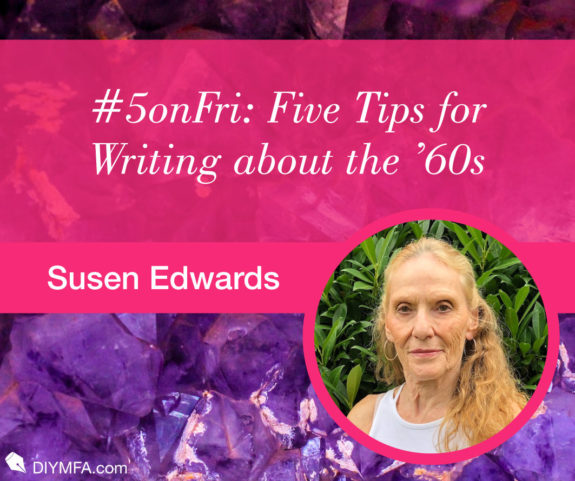I’m a stickler for detail, as all writers should be. When I read about an event, a film, a song, or a place I’m familiar with, I’ll do a quick internet search to see if the writer has done their homework. When I find an error, it makes me question the reliability of the author, as well as the reliability of the narrative. With Wikipedia and other resources at our fingertips, fact-checking can and should be a part of every writer’s toolbox.
What a Trip is set in the late ’60s, a time of social and political upheaval. I was fortunate enough to have come of age during the era, but I couldn’t trust my memory’s timeline. I researched every historical event, every piece of music, and every detail in the novel.
Writing that includes historical elements brings your reader into the scene, allowing them to engage with your characters and the story. Details on transportation, clothing, conversation/dialect/slang, music, entertainment, books, and food help set the stage. If you describe your character’s hairstyle, makeup, and clothing, she’ll come alive. If music is playing in the background, name the artist and song. If a car figures in your scene, mention the make, model, year, and color. Remember, balance is key. Don’t overdo it.
My five tips for writing about any era are:
- Do your research
- Double-check your facts
- Put yourself into the scene
- Live life through your characters
- Make them believable.
When writing about the ’60s, it’s important to focus on these five areas:
1. The Vietnam War and Political Climate
The Vietnam War was the first truly televised war, bringing battles and body count into the homes of most Americans nightly. Anti-war protests began in the mid-1960s on college campuses and in left-wing circles, but by the end of the decade, anti-war sentiment became more mainstream.
The largest nationwide anti-war protest in history occurred on November 15, 1969, followed two weeks later by the Selective Service System’s Draft Lottery on December 1, also known as Nixon’s Draft Lottery. It determined the order of call to military service for men born from 1944 through 1950. The Kent State Massacre on May 4, 1970, in which the Ohio National Guard killed four and wounded nine students during a peace rally on the Kent State campus, further ignited anti-war protests.
Political tension was palpable, as was the clash between the Greatest Generation and the Baby Boomers. Times were changing, social and political views were under attack. This tension, more than anything, set the stage for the decade, and decades to come.
A great deal of information about the Vietnam War and societal sentiment is available online. Whether you’re writing from the point of view of someone opposing or someone supporting the political agenda of the day, find sources from the time. Photos from campus rallies and marches on Washington will give you a feel for the energy and magnitude of the events. Be sure to check out close-ups of the people: their clothing and hairstyles, their facial expressions, their attitude, and any signs they’re carrying.
2. Music and Media in the ’60s
While most periods are defined by their music, the Woodstock era is often regarded as the pinnacle of self-expression that defines this time. Rock ’n roll, folk, and protest songs left their mark on society and in history. Musicians such as Bob Dylan, John Lennon, Country Joe and the Fish, and Neil Young were politically outspoken in their music.
References to popular music in your writing will help ground your reader in history. Make sure you research albums, hits from the albums, and popular titles; above all, coordinate release dates to events in your story.
Listening to the music of the time can help put you in the mood to write about the ’60s. As a special treat for your readers, create a playlist on Spotify or another platform. Whether you include it in your novel or your social media, you’ll give your readers one more connection to you and the setting of your story. You’ll find my What a Trip playlist on my website, or on Spotify.
Mentions of specific publications, books, and TV shows also help anchor your reader. Once again, be sure to research publication/release dates. Wikipedia can provide you with lineups of TV shows of the day.
Reminder: If you plan to include lyrics or quotes from any songs or books, get permission before publishing!
3. Sex, Drugs, and Rock ’n Roll
The ’60s were a time of sexual revolution. The advent of birth control pills earlier in the decade gave women the freedom to express their sexuality without fear of unwanted pregnancy. I don’t refer directly to the Women’s Movement in What a Trip, but my female characters are emerging from the constraints of their parents’ generation in terms of their sexuality, their goals, and their dreams.
Abortion was illegal in 1969 when Melissa, one of the major characters in What a Trip, finds herself pregnant. A young woman faced with an unwanted pregnancy could give birth and place the baby up for adoption, or have a “back alley” or self-induced abortion, which put the life of the mother in jeopardy. Melissa is able to convince her doctor that she is mentally unfit to bear a child and is granted an abortion. A huge amount of pre-Roe v. Wade information is available online, especially in these post-Roe days.
Marijuana and psychedelics played a huge part in the mores of the time. When writing about the ’60s, make sure not only to use the drug slang of the day but also consider having your characters indulge in the most popular “highs” of the time, which included pot/grass, hash, acid, and mescaline.
4. The Occult
Many readers forget (or never knew) the widespread interest in the occult during the 1960s. Popular films such as Rosemary’s Baby and TV shows such as Bewitched ignited curiosity about the supernatural. Eastern philosophy, reincarnation, astrology, witchcraft (Wicca), tarot, and psychic phenomena featured prominently in popular culture, once again challenging the traditional, conservative values of prior generations.
5. Language of the ’60s
Characters in any novel should speak naturally, using slang and idioms of the times. When writing dialogue, a writer needs to get into their characters’ heads and bodies. How would she say that? What would his reaction be? Expressions such as “sock it to me” and “flower power” were more a part of mainstream media than “heavy, man” or “far out.” But how would a writer know the difference? Use this handy reference tool.
Hippie conversations were peppered with profanities and layered with slang. I also recommend watching movies such as Easy Rider and Woodstock, the film, to study how people spoke. Remember: Being cool was everything. Barriers came down. Just don’t overdo it.
Finally, remember writing is an adventure, so enjoy the journey—whenever and wherever your writing takes you!

Susen Edwards is the founder and former director of Somerset School of Massage Therapy, New Jersey’s first state-approved and nationally accredited postsecondary school for massage therapy. During her tenure she was nominated by Merrill Lynch for Inc. Magazine’s Entrepreneur of the Year Award. After the successful sale of the business, she became an administrator at her local community college. She is currently secretary for the board of trustees for her town library and a full-time writer. Her passions are yoga, cooking, reading, and, of course, writing. Susen lives in Central New Jersey with her husband, Bob, and her two fuzzy feline babies, Harold and Maude. She is the author of Doctor Whisper and Nurse Willow, a children’s fantasy.
You can find her on her website, and follow her on Facebook, and Instagram.







